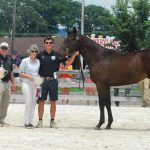What’s being done to Laurel Park track: “A good cushion serves one purpose”
When the Maryland Jockey Club and Maryland Thoroughbred Horsemen’s Association last Thursday announced their intention to race at Laurel this past weekend, a lot of folks scoffed.
John Passero’s involvement had only been agreed to Tuesday, the thinking went. If the dirt track had been in such bad condition then, what could he possibly have accomplished in a day or two to make it safe to race?
Yet through Sunday, praise for the racing surface was nearly universal.
“Like night and day,” is how one assistant trainer described the difference between the racing strip prior to and since Passero’s arrival.
“Beautiful… like a carpet,” is how jockey Jevian Toledo described Thursday’s track, when it was fast and dry.
And of course, the weekend’s racing, over wet tracks both days, went off without a hitch, which is the most important metric.
All of which raises an obvious question: what exactly did Passero do that could have made such a consequential difference in such a short time? Passero was retained by the Maryland Thoroughbred Horsemen’s Association as their track consultant after racing in Maryland was halted by a spate of equine injuries and deaths.
A good place to start is with what Passero didn’t find.
CHECK OUT THE LATEST OFF TO THE RACES RADIO!
“I don’t think there’s any issues with the base,” he said April 27.
Racetracks are typically built in layers, with a sandy “cushion” placed atop a limestone base, which itself rests on a sub-base. Because horses are half-ton animals running on spindly legs, it is imperative that the cushion be deep enough to soften the impact of their hitting the track and of consistent depth all the way around; that consistency is key. Issues with the base would have required much more extensive work.
Instead, what Passero found was a combination of cushion materials he thinks needs adjusting and maintenance practices that didn’t work with the cushion material.
“Because of the composition of the cushion, it’s very susceptible to too much water,” Passero explained. “On a sunny day, normal ‘fast’ track, you’ve got to be really careful with water.”
That, he said, was less of an issue with wet days, as were the norm this past weekend, because the track crew could simply seal the track. On Friday, with wet weather looming, his team rolled the track four times, he said, to keep the rain water on the surface.
But on dry days, when normal maintenance is a combination of watering the track and harrowing it, that’s when the problems arose, according to Passero.
“A good cushion serves one purpose: that’s to slow down horses’ hooves before they hit the base,” Passero said. “This cushion, when it gets a lot of water, especially when it’s a nice day and you’re pouring water on it, it starts to lose some of its body or conditioning. When I walked the racetrack when it was fast, it felt very soft to me, not able to hold up a horse like it should.”
So Passero modified maintenance practices, changing the types of harrows used on the tractors, altering the speed and direction in which the tractors travel, and reducing the amount of water used on the track.
“The main thing is just put a little less water in it and harrow the hell out of it,” he explained.
In the longer term, Passero hopes for the cushion at Laurel and the one at Pimlico to be similar to each other and more similar to what they were during his time as the MJC track super, which ended in 2004. He said he has sent soil samples out to work towards the ideal mixture.
“I want to amend the cushion so it’s closer to the way Laurel was when I was here 10, 15 years ago,” he said.
At a May 2 meeting of the Maryland Racing Commission, Mike Rogers, acting president of the Maryland Jockey Club, issued what he termed a “positive report” on the condition of the racetrack. It had taken last-minute negotiations and an impending emergency meeting of the Commission, which took place April 25, to get an agreement hammered out allowing Passero to inspect the Laurel track.
While noting that his company all along had taken “the position that the track was safe,” he acknowledged that the track team at Laurel had “adopted all of [Passero’s] recommendations” and were pleased with the situation.
“Clearly, both sides are feeling the track is in a safe place,” Rogers said.
The Laurel race meet has one racing weekend left before action shifts to Pimlico. Passero said he expects to be at Laurel through the end of June, at the horsemen’s request. But don’t expect him at Pimlico, Rogers said: “His access agreement is for Laurel only.”
Maryland horsemen are hopeful that the track issues are about to be in the rearview mirror.
If not – if the injury issues recur — the scrutiny that put the sport – for all the wrong reasons – on the evening news and in the daily newspaper will only increase, and protestors, like the representative of the Horseracing Wrongs group who called on the Commission “to work towards the complete abolition of horse racing in Maryland,” will only grow louder.
But horsemen are confident things are on the right track now.
“A lot of the older horsemen, who saw what John did here in Maryland and around the country, they have a lot of confidence in him,” trainer and MTHA president Tim Keefe said on Off to the Races-Maryland April 29. “Obviously, he’s very knowledgeable, but it’s that confidence he instills.”
LATEST NEWS
















